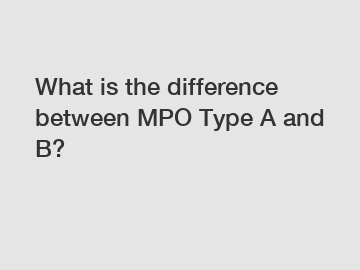What is the difference between MPO Type A and B?
What is the difference between MPO Type A and B?
MPO (Multi-Fiber Push-On) connectors are widely used in the field of optical communication. They are a type of fiber optic connector that can accommodate multiple fibers within a single ferrule. MPO connectors are commonly used in high-density applications and provide a quick and efficient way to connect multiple fibers.
There are two main types of MPO connectors, known as Type A and Type B. These types differ in terms of their polarity methods and pin arrangements. In this article, we will explore the difference between MPO Type A and B connectors.

Type A Connectors: .
MPO Type A connectors are designed with a key-up/key-up (or key-up/up) configuration. This means that the keyway of the connector is facing up on both the plug and the adapter. In other words, when the connectors are mated, the keyways are aligned on the top side of both connectors. Type A connectors are commonly used in parallel optic links where the transmission is based on multi-mode fibers.
Type B Connectors: .
On the other hand, MPO Type B connectors are designed with a key-up/key-down (or key-up/down) configuration. The keyway of the plug connector is facing up, while the keyway of the adapter connector is facing down. When the connectors are mated, the keyways are aligned at opposite sides. Type B connectors are typically used in applications that involve a combination of multi-mode and single-mode fibers.
Polarity Methods: .
The main difference between MPO Type A and B connectors lies in their polarity methods. Polarity refers to the way fibers are connected or mapped from one end of the link to the other. In fiber optic systems, proper polarity is essential to ensure that the transmit signal from one end matches the receive signal at the other end.
Type A connectors follow a method called “Straight-Through” polarity. In this method, the fibers in the same order are connected from one end to the other. This means that fiber 1 in the plug is connected to fiber 1 in the adapter, fiber 2 is connected to fiber 2, and so on. Type A connectors are used when a straight-forward signal transmission is required, for example, in intra-building backbone links.
Type B connectors, on the other hand, use a method called “Crossed” polarity. In this method, the fibers are crossed between the plug and the adapter. This means that fiber 1 is connected to fiber 12, fiber 2 is connected to fiber 11, and so on. Type B connectors are used when a signal needs to be transmitted across different floors or sections within a building.
Conclusion: .
In conclusion, the main difference between MPO Type A and B connectors is their polarity methods. Type A connectors have a key-up/key-up configuration and follow a straight-through polarity method, while Type B connectors have a key-up/key-down configuration and use a crossed polarity method. The choice between these two types depends on the specific requirements of the optical communication system.
If you have any further questions or need assistance with MPO connectors, please feel free to contact us. We are here to help!
If you want to learn more, please visit our website Audio Cable Supplier, Av Cable Manufacturer, Butterfly Fiber Optic Cables.
401
0
0


Comments
All Comments (0)